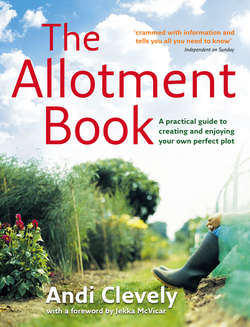Читать книгу The Allotment Book - Andi Clevely - Страница 33
INCREASING YOUR SPACE
ОглавлениеAlthough your plot might seem adequate, even enormous at first, it can quickly fill up with conventionally spaced crops unless you adopt measures to stretch the available space. Gardening in beds might appear to increase the area devoted to paths, but the more intensive plant spacings used can actually raise total yields; forest gardening (see page 31) exploits the vertical dimension by adding extra tiers of productive plant growth above normal ground-level vegetables.
Many plants can be grown for height rather than spread to save space. Fruits like apples, plums, gooseberries and redcurrants adapt readily to restricted forms such as cordons, espaliers and fans on posts and wires, or as short (often decorative) standards with branches spreading above ground level plants. Tall varieties of peas or beans and trailing forms of cucumbers or squashes can all be trained on upright structures to limit spread, releasing soil at their base for other shade-tolerant plants.
If your plot lies on a slope, consider contouring this in a series of level terraces supported by low walls or banks that can be used for trailing and scrambling plants. Raised beds provide the same growing space as at ground level, but are more comfortable to manage and offer vertical support for extra crops grown round their sides. Fencing or dividing parts of the plot with screens provides sites for extra climbing plants, as do the sides of a fruit cage. And don’t forget shed walls, which can be clothed with seasonal or permanent climbers, together with shorter plants in window boxes and ground-level containers or on shelves (see page 42).
The beds can be permanent, defined with fixed edging and separated by maintained paths, or marked out with string and pegs, with intervening paths trodden in. Most paths are straight, but elegant curves are equally practical and can introduce a welcome aesthetic element into a functional landscape. You will find that managing the beds from the paths rather than by walking between rows of vegetables eliminates compaction of the soil and so reduces the need to dig the beds regularly.
The critical size for a bed is its width – it must allow you to reach the middle without walking on the soil. Most people find 90–120cm (3–4ft) is a comfortable width. Narrow beds may be as long as you like, although much more than 3m (10ft) means a long walk round to the other side. Plants are usually arranged in short rows from side to side for easy cultivation. Square beds, 90–120cm (3–4ft) each way and accessible from all sides, are good for gradually colonizing new ground, with each square devoted to a single crop.
Both styles can be transformed into raised beds by building timber edges or walls to a convenient height, usually 10–20cm (4–8in) or as much as 60cm (2ft) if you have difficulty with bending or mobility. A raised bed of this kind is also an effective remedy for serious drainage problems. Paths should be at least 30cm (12in) wide.
No-dig beds Annual digging can destroy soil structure, dry out light soils and bring more weed seeds to the surface to germinate. If you adopt a minimal cultivation or ‘no-dig’ policy, remember that it is worth deeply digging over the plot or individual beds initially, to open up heavy or compacted ground, improve aeration and work in manure or compost. Thereafter it should be enough to cultivate the top 10–20cm (4–8in) of soil, where root growth tends to be concentrated, loosening the surface and turning in annual dressings or 8cm-(3in-) deep mulches of organic material. Decreasing yields or poor drainage will indicate if deep digging and manuring will need to be repeated in the future.
